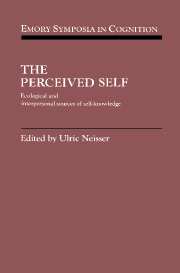Book contents
- Frontmatter
- Contents
- Preface
- List of contributors
- Part I Introduction
- Part II The concept of an ecological self
- Part III The interpersonal self and its implications
- 8 The self born in intersubjectivity: The psychology of an infant communicating
- 9 On the interpersonal origins of self-concept
- 10 Infants' knowledge of self, other, and relationship
- 11 The role of feelings for an interpersonal self
- 12 Spontaneous communication and the foundation of the interpersonal self
- 13 Autism, affordances, and the self
- 14 Through feeling and sight to self and symbol
- 15 G. H. Mead and Martin Buber on the interpersonal self
- 16 Cognitive science, other minds, and the philosophy of dialogue
- Author index
- Subject index
14 - Through feeling and sight to self and symbol
Published online by Cambridge University Press: 29 March 2010
- Frontmatter
- Contents
- Preface
- List of contributors
- Part I Introduction
- Part II The concept of an ecological self
- Part III The interpersonal self and its implications
- 8 The self born in intersubjectivity: The psychology of an infant communicating
- 9 On the interpersonal origins of self-concept
- 10 Infants' knowledge of self, other, and relationship
- 11 The role of feelings for an interpersonal self
- 12 Spontaneous communication and the foundation of the interpersonal self
- 13 Autism, affordances, and the self
- 14 Through feeling and sight to self and symbol
- 15 G. H. Mead and Martin Buber on the interpersonal self
- 16 Cognitive science, other minds, and the philosophy of dialogue
- Author index
- Subject index
Summary
To know oneself is to know oneself as a person among others. In order to acquire a developed concept of self, therefore, children need to appreciate the nature of persons and to recognize the existence of other selves with whom they have much in common but from whom they are differentiated. A principal concern of this chapter is to consider how very young children come to apprehend their commonality with other people and grasp the ways in which different selves occupy distinct psychological orientations toward an objectively existing world. I shall emphasize how interpersonal communication of feeling is especially important for individuals' experience of connectedness with others, and suggest that vision plays a special but not indispensable role in enabling young children to discover the fact that different people have different attitudes and points of view vis-à-vis a shared environment that includes the children themselves.
My second concern is with young children's developing capacity to symbolize. To symbolize is to treat one thing in such a way that it stands for another. This statement is a crude oversimplification, but let that be.
- Type
- Chapter
- Information
- The Perceived SelfEcological and Interpersonal Sources of Self Knowledge, pp. 254 - 279Publisher: Cambridge University PressPrint publication year: 1994
- 2
- Cited by



